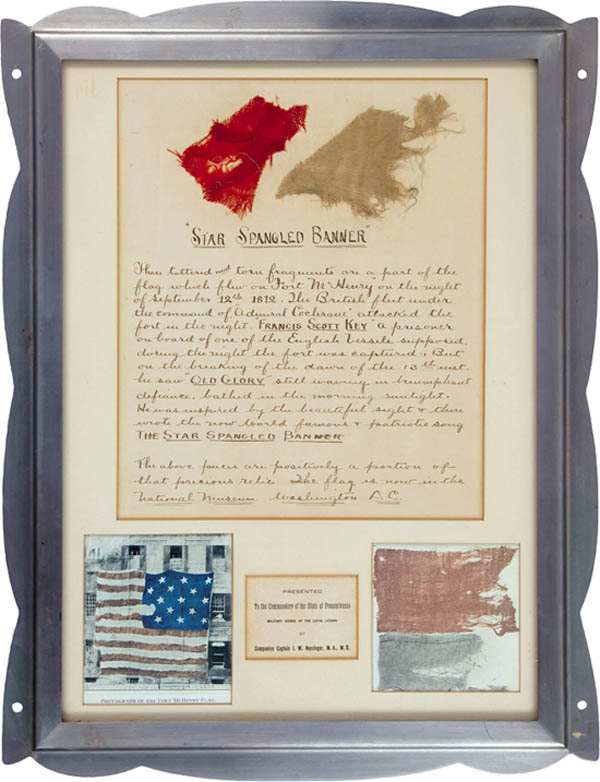Original Star Spangled Banner Fragments Up For Bid, For First Time In Modern Auction History
It is the first time in modern auction history, to the knowledge of Heritage specialists, that any fragments of the flag have appeared in a public auction.
"There is no American symbol more potent than our flag," said Dennis Lowe, Director of Arms & Militaria at Heritage, "and there is no version of our flag more important than the Star Spangled Banner. These fragments are a part of our collective history, and should be valued as such by serious collectors of Americana."
The history of these amazing fragments, coming to auction from a high-end collector who has owned them for the last 30 years, is rock solid and indisputable. Its common knowledge that the flag, which was commissioned in Baltimore by Brevet Lt. Col. George Armistead in 1814, went home with him after the battle, where it stayed for the remainder of his life, passing to his wife upon his death and subsequently to, first, Armisteads daughter and then to his son, who loaned it to the Smithsonian in 1907. In 1910 the gift was made permanent.
"When the Smithsonian got the flag and compared it to the original specs, they found that a full eight feet of the flag was missing on the fly end," said Lowe. "The family had, over the years, snipped off pieces of the flag as souvenirs to give friends, family and visitors. That accounts for these fragments and the diminished size of the flag."
The current fragments were donated in 1914 to the Military Order of the Loyal Legion of the United States Museum in Philadelphia a treasury of the holdings of that patriotic order organized just after Lincolns death in April 1865 by Union military officers who fought in the Civil War by former Union officer, author and all-around Renaissance man John Heysinger, whose clean script details the fragments on the manuscript mount.
"These tattered and torn fragments are a part of the flag which flew on Fort McHenry on the night of September 12th 1812," wrote Heysinger, in part, of the battle which actually occurred on Sept. 14, 1814. "The above pieces are positively a portion of that precious relic. The flag is now in the National Museum Washington D.C."
Also accompanying the pieces is a booklet, printed in 1914 in Philadelphia by John Wanamaker, commemorating the 100th anniversary of the battle, in which are pictured these exact flag fragments, with the caption stating "A portion of the very Star Spangled Banner that inspired that song. A photographic reproduction of portions of the original Fort McHenry flag now in the possession of the Ridgway Library, Philadelphia."
Further documentation on the provenance of the piece comes from an accompanying letter, dated April 4, 1969, from Smithsonian Institution representative Donald E. Kloster, to the Union League of Philadelphia, where many of the Loyal Legion artifacts were stored and displayed, concerning these fragments.
"Weve had consultation from the most respected and well-known flag experts in the country," said Lowe. "They all agree that this is unquestionably authentic."
All of this does, however, beg the question: If the family gave away so many snips of the flag, shouldnt there then be numerous other pieces of it to have surfaced from libraries, attics and bookshelves across the nation?
"I would certainly imagine that was the case at one point," said Lowe, "but its likely that people have no idea what they have or had. For anyone that got fragments themselves, in person, from the Armistead family, there was no need to document it absolutely. They knew just what they had and probably threw it in a drawer or a book to take out occasionally to show friends. I would imagine many of the fragments simply got lost or thrown out by people who had no idea what it was they had."
"That said, there must be some that survive somewhere," said Lowe, "its just that no one knows where they are."
Heritage Auctions, headed by Steve Ivy, Jim Halperin and Greg Rohan, is the worlds third largest auction house, with annual sales more than $700 million, and 600,000+ online bidder members. For more information about Heritage Auctions, and to join and gain access to a complete record of prices realized, along with full-color, enlargeable photos of each lot, please visit HA.com.






